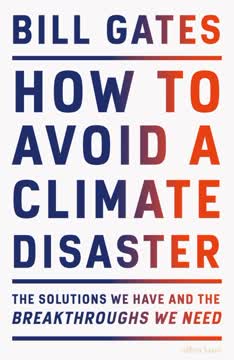Key Takeaways
1. Solar energy's potential to power the planet hinges on innovation
The year 2050 could see cities around the globe choked by pollution and the planet reeling from catastrophic climate change; or it might see a world equipped to address a range of global challenges.
Two divergent futures. The world stands at a crossroads, with solar energy playing a pivotal role in determining which path we take. In one scenario, solar's growth stagnates, leaving us reliant on fossil fuels and facing dire environmental consequences. In the other, innovation propels solar to meet a third of global electricity demand by 2050 and a majority of energy needs by century's end.
Three types of innovation required:
- Financial innovation to attract massive capital investment
- Technological innovation to improve efficiency and reduce costs
- Systemic innovation to redesign power grids and energy markets
Without these innovations, solar risks hitting an economic ceiling as its value declines with increased penetration. The challenges are significant, but so are the potential rewards of a clean, abundant energy future.
2. Financial engineering can unlock massive capital for solar deployment
If the planet is going to decarbonize, the task will not be accomplished solely by eliminating fossil fuels from electricity generation and powering on-road vehicles with electricity instead of oil derivatives.
Tapping institutional investors. The solar industry needs to access vast pools of capital from pension funds, insurance companies, and sovereign wealth funds to finance its continued growth. These investors collectively manage over $100 trillion, but currently invest less than 1% in infrastructure projects.
Innovative financial instruments:
- YieldCos: Publicly traded companies that own operating solar assets
- Securitization: Bundling solar loans into tradable securities
- Green bonds: Debt instruments specifically for clean energy projects
These financial innovations can make solar projects more attractive to large investors by improving liquidity and reducing risk. Public policy can play a role in encouraging these developments, but care must be taken to avoid creating long-term dependencies on subsidies.
3. Business model innovation is revolutionizing energy access in developing countries
Few would dispute that solar energy has emerged as one of the most important technologies—if not the most important one—of the twenty-first century.
Pay-As-You-Go revolution. Innovative business models like Pay-As-You-Go (PAYG) are bringing electricity to millions in Africa and Asia who lack grid access. Companies like M-KOPA and Off-Grid Electric combine mobile payments, low-cost solar panels, and efficient appliances to offer affordable energy services.
Impact and potential:
- Over 500,000 households had solar home systems by 2015
- PAYG start-ups raised over $200 million in 2016
- Potential to reach 1 billion people with meaningful electricity access by 2030
These models not only provide energy access but also introduce credit and asset ownership to underserved populations. As costs continue to fall and technology improves, off-grid solar could play a crucial role in achieving universal energy access.
4. Next-generation solar technologies promise higher efficiency and versatility
If you're surprised that you haven't heard of perovskite, don't be. Outside the rarefied world of academia, where researchers confer celebrity status on the latest efficiency holder, very few people understand how remarkable this new material is.
Perovskite breakthrough. Perovskite solar cells have achieved unprecedented increases in efficiency, rising from 3.8% in 2009 to over 22% in 2016. This rapid progress outpaces any previous solar technology and holds promise for even higher efficiencies.
Advantages of emerging technologies:
- Potential for higher efficiency than silicon (theoretical limit of 33%)
- Flexibility and lightweight nature enable new applications
- Lower manufacturing costs through simple production processes
While challenges remain in stability and scaling up production, these new technologies could overcome the limitations of silicon solar panels. Combining perovskites with silicon in tandem cells offers an evolutionary path to higher efficiencies in the near term.
5. Converting sunlight into storable fuels could transform global energy systems
To reach solar's potential, all these non-PV technologies—including convenient solar-generated fuels and CSP plants that generate electricity 24/7—will need to advance dramatically.
Beyond electricity production. Solar fuels represent a potential game-changer by converting sunlight directly into energy-dense, easily storable forms like hydrogen or carbon-based liquids. This technology could address the intermittency challenge of solar PV and provide clean energy for sectors difficult to electrify.
Promising developments:
- Artificial leaf prototypes splitting water to produce hydrogen
- Hybrid systems using bacteria to produce liquid fuels from sunlight and CO2
- Advanced concentrated solar power (CSP) plants with built-in thermal storage
While still in early stages, these technologies offer pathways to harness solar energy for a much broader range of applications, potentially displacing fossil fuels across multiple sectors of the economy.
6. Systemic innovation in power grids is crucial for integrating solar at scale
Yet a supergrid would create its own host of challenges, which Liu's tome addresses inadequately despite devoting more than 300 pages to engineering details.
Rethinking grid architecture. As solar penetration increases, power grids must evolve to handle its intermittent nature. This requires both physical and operational changes to the way electricity is transmitted, distributed, and managed.
Potential grid innovations:
- Supergrids: Long-distance, high-voltage transmission to balance regional supply and demand
- Microgrids: Localized, smart grids that can operate autonomously or connect to the main grid
- Hybrid approach: Combining aspects of both to create a flexible, resilient system
These changes must be accompanied by new market designs and regulatory frameworks that properly value the attributes of different power sources and encourage investment in flexible resources. The goal is a grid that can accommodate high levels of solar while maintaining reliability and affordability.
7. Energy storage alone cannot solve solar's intermittency challenges
Unfortunately, although pairing solar with grid-tied battery storage may be cognitively satisfying, it is no silver bullet.
Limitations of batteries. While batteries, especially lithium-ion, have seen dramatic cost reductions, they are not a complete solution to solar's variability. Batteries excel at short-term storage but become prohibitively expensive for long-duration or seasonal storage needs.
Diverse flexibility resources needed:
- Pumped hydro storage for large-scale, long-duration storage
- Demand response to shift electricity consumption patterns
- Flexible thermal power plants to ramp output up and down quickly
- Power-to-gas technologies for seasonal storage
A mix of these technologies, along with improved forecasting and grid management, will be necessary to cost-effectively integrate high levels of solar power. No single technology can provide all the flexibility required.
8. Linking electricity with other sectors enhances solar's flexibility and reach
Connecting the transportation and electric power sectors is an important step en route to reaching the long-term target of using the sun to power a majority of humanity's energy needs by century's end.
Sector coupling. Integrating the electricity sector with transportation, heating, and industrial processes can provide additional flexibility for solar integration and expand its impact on decarbonization efforts.
Examples of sector linkages:
- Electric vehicles as mobile batteries for grid balancing
- Power-to-heat systems for storing excess solar energy
- Solar-powered desalination to address water scarcity
- Electrification of industrial processes currently reliant on fossil fuels
These connections create new ways to store and utilize solar energy, potentially increasing its value and enabling higher penetration levels. They also offer pathways for solar to displace fossil fuels in hard-to-decarbonize sectors.
9. U.S. leadership in energy innovation is vital but under threat
American politicians are fond of calling the United States a shining "city upon a hill," and when it comes to energy innovation, America has historically lived up to this billing.
Innovation ecosystem at risk. The United States has long been a leader in energy innovation, but its position is threatened by stagnant funding and increased competition from countries like China. Maintaining this leadership is crucial for both economic competitiveness and addressing global energy challenges.
Policy recommendations:
- Increase funding for energy R&D across multiple agencies
- Expand successful programs like ARPA-E
- Support demonstration projects for first-of-a-kind technologies
- Reform regulations to encourage innovation in power markets
- Engage in international collaboration while protecting U.S. interests
By investing in innovation, the U.S. can develop new technologies, capture a share of the growing clean energy market, and lead global efforts to transition to sustainable energy systems. Failure to do so risks ceding technological and economic leadership to other nations.
Last updated:
Review Summary
Taming the Sun explores the challenges and potential of solar energy. Sivaram argues for increased innovation in technology, financing, and grid systems to overcome solar's limitations. Reviewers praise the book's comprehensive overview of the solar industry, balancing technical details with accessibility. Some critique the policy focus and repetitive sections. Overall, readers find it informative and thought-provoking, highlighting the complexities of transitioning to renewable energy. The book emphasizes the need for continued research and development to maximize solar's impact on global decarbonization efforts.
Similar Books










Download PDF
Download EPUB
.epub digital book format is ideal for reading ebooks on phones, tablets, and e-readers.




